



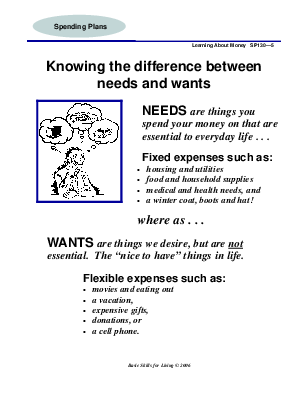
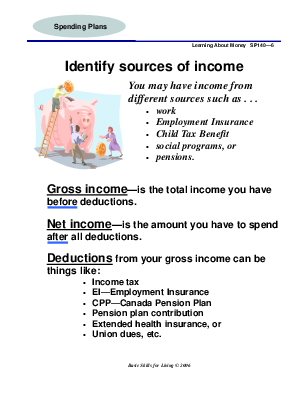

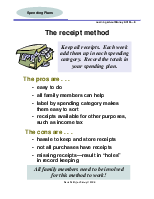
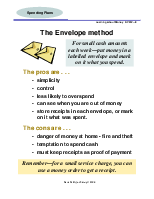
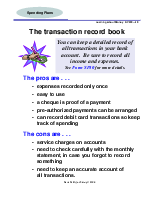
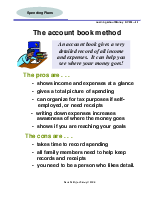
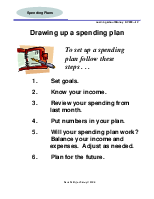
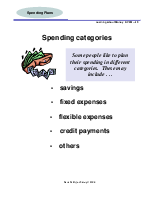
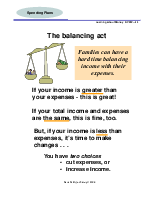
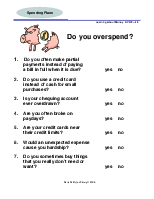
Learning About Money SP series
In this section are 14 hand poster/overhead masters that may be duplicated for educational use. This series supports the concepts found in the Spending Plansmoduleof this resource. These masters make good hand posters, handouts for Stage Three, and some are suitable for Stage Two readers. They can also be made into overheads for presentations.
Review the Learning About Money Video Scripts for background information on the topics covered. See the segment, Drawing Up A Spending Plan, for further information.
This segment is an excellent visual tool for imparting different ways that learners can:
• Understand why a spending plan is needed
• Determine how financial goals are set
• Be able to know the difference between needs and wants
• Identify income, and know the difference between gross and net income
• Learn four ways to track spending, as well as
• Follow the steps in how to make and balance a spending plan.
These are the hand poster/overhead masters that follow in this file—each has a number, so you can identify the order—note that the page number is given following the dash. Or, you can follow the links below.
SP100—2 Discussion Starters
(See page 2 of the education module for discussion topics and ideas.)
SP110—3 Why do I need a spending plan?
SP120—4 Setting financial goals
SP130—5 The difference between needs and wants
SP140—6 Identify sources of income
SP150—7 Tracking your spending
SP151—8 The receipt method
SP152—9 The envelope method
SP153—10 The transaction record book
SP154—11 The account book method
SP160—12 Drawing up a spending plan
SP161—13 Spending categories
SP162—14 The balancing act
SP170—15 Do you overspend?
These hand poster/overhead masters are for educational use and may be duplicated for individual or group learning.
Funding has been provided by the National Literacy Secretariat, Human Resources Development Canada
Basic Skills for Living © 2006
Learning About Money SP100–2
What do you think about . . .
♦ Why do people have problems managing their money?
♦ What are some of the expenses we need to plan ahead for?
♦ How can people avoid buying on impulse?
♦ How can you set up a spending plan?
♦ What are some of the ways you can track your spending?
 ♦
Besides money—what other resources do you have to use for the benefit
of your family?
♦
Besides money—what other resources do you have to use for the benefit
of your family?
Learning About Money SP110—3
Why do I need a spending plan?
 can
help you . . .
can
help you . . .
• buy what you need and want within your income
• give you a record of where your money goes
• cut down on worry over money
• give you a chance to talk with your family about the future.
A spending plan can also help you see if a financial problem lies ahead.
Learning About Money SP120—4 Setting financial goals
 GOAL$
GOAL$ To set a financial goal decide on the following:
• total cost of the goal,
• the target date, and
• the cost per month.
For example—You want to save $700 for a vacation in a year. You will need to save . . . $700 ÷ 12 = $58.33 a month for this goal.
Now set a goal for each of the following:
immediate (within 2 months)
short-term (3 - 12 months)
long-term (1 - 5 years)
Learning About Money SP130—5
 NEEDSare things you spend your money
on that are essential to everyday life . . .
NEEDSare things you spend your money
on that are essential to everyday life . . .
Fixed expenses such as:
• housing and utilities
• food and household supplies
• medical and health needs, and • a winter coat, boots and hat!
where as . . .
WANTSare things we desire, but are not essential. The “nice to have” things in life.
Flexible expenses such as:
• movies and eating out
• a vacation,
• expensive gifts, • donations, or • a cell phone.
Learning About Money SP140—6
 You
may have income from
You
may have income from
different sources such as . . .
• work
• Employment Insurance
• Child Tax Benefit • social programs, or • pensions.
Gross income—is the total income you have before deductions.
Net income—is the amount you have to spend after all deductions.
Deductions from your gross income can be things like:
• Income tax
• EI—Employment Insurance
• CPP—Canada Pension Plan
• Pension plan contribution • Extended health insurance, or • Union dues, etc.
Learning About Money SP150—7
The four methods are . . .
 Receipt method
Receipt method • a receipt for every expense
• sort and total each week
• record and get a monthly total for each spending category.
 Envelope
method
Envelope
method • a cash management system
• use for some spending categories each week e.g. food, bus fare etc.
Transaction record book
• keeps track of all banking transactions
• can use different accounts for different purposes.
Account book method
• gives a more detailed record of where your money is spent
Уважаемый посетитель!
Чтобы распечатать файл, скачайте его (в формате Word).
Ссылка на скачивание - внизу страницы.